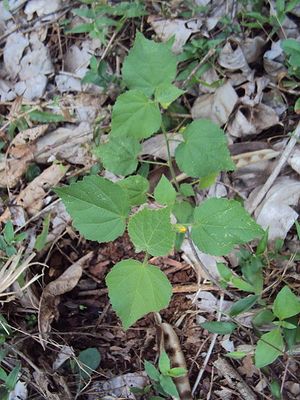Note: This is a project under development. The articles on this wiki are just being initiated and broadly incomplete. You can Help creating new pages.
Sida cordifolia - Bala
Bala or Sida cordifolia (ilima, flannel weed, bala, country mallow or heart-leaf sida) is a perennial shrub of the mallow family Malvaceae native to India. Sida cordifolia or Bala is a plant. The seeds and root are used to make medicine. Sida cordifolia contains ephedrine, which is an amphetamine-like stimulant that can cause harmful side effects. ... Some people use Sida cordifolia as a stimulant, painkiller, and tonic; and to increase urine production and raise sexual arousal.
Contents
Uses
Bleeding piles, Diarrhea, Fever, Gonorrhea, Aphrodisiac, wounds, Ophthalmia, Painful urination, Paralysis, headache, loss of voice[1]
Parts Used
Chemical Composition
The following alkaloids were reported from S. cordifolia growing in India and β-phenethylamine, ephedrine, pseudo-ephedrine, S-(+)-Nb-methyltryptophan methyl ester, hypaphorine, vasicinone, vasicinol, choline, and betaine.
Common names
| Language | Common name |
|---|---|
| Kannada | Hethutti, Bili kurunthotti |
| Hindi | Bariar, Kungyi Khareti, Kharenti |
| Malayalam | Vellooram, Velluram |
| Tamil | Mayir-manikham |
| Telugu | chirubenda |
| Marathi | NA |
| Gujarathi | NA |
| Punjabi | NA |
| Kashmiri | NA |
| Sanskrit | Bala, Batyalaka |
| English | Country mallow |
Habit
Identification
Leaf
| Kind | Shape | Feature |
|---|---|---|
| alternate | stipulate | The leaves are alternate, stipulate, paripinnate compound, very numerous, closely placed, rachis 8.8-12.5 cm long, narrowly furrowed, slender, pubescent, with an erect linear gland between the leaflets of each pair, leaflets 16-24, very shortly stalked 2-2.5 cm long 1-1.3 cm broad, slightly overlapping, oval oblong, obtuse, at both the ends |
.[2]
Flower
| Type | Size | Color and composition | Stamen | More information |
|---|---|---|---|---|
| bisexual | 2.5 cm long | bright yellow | 5-20 | The racemes are few-flowered, short, erect, crowded in axils of upper leaves so as to form a large terminal inflorescence stamens barren; the ovary is superior, unilocular, with marginal ovules. |
Fruit
| Type | Size | Mass | Appearance | Seeds | More information |
|---|---|---|---|---|---|
| short legume | 7.5–11 cm long, 1.5 cm broad | clearly grooved lengthwise, Lowest hooked hairs aligned towards crown | oblong, obtuse, tipped with long style base, flat, thin, papery, undulately crimpled, pilose, pale brown. | 12-20 seeds | {{{6}}} |
Other features
List of Ayurvedic medicine in which the herb is used
- Vishatinduka Taila as root juice extract
Where to get the saplings
Mode of Propagation
How to plant/cultivate
Prefers a lighter, sandy soil in a sunny position[3]
Commonly seen growing in areas
Tropical, Subtropical plains, Sandy soil.
Photo Gallery
References
External Links
- Pages that are stubs
- Ayurvedic Herbs known to be helpful to treat Bleeding piles
- Ayurvedic Herbs known to be helpful to treat Diarrhea
- Ayurvedic Herbs known to be helpful to treat Fever
- Ayurvedic Herbs known to be helpful to treat Gonorrhea
- Ayurvedic Herbs known to be helpful to treat Aphrodisiac
- Ayurvedic Herbs known to be helpful to treat wounds
- Ayurvedic Herbs known to be helpful to treat Ophthalmia
- Ayurvedic Herbs known to be helpful to treat Painful urination
- Ayurvedic Herbs known to be helpful to treat Paralysis
- Ayurvedic Herbs known to be helpful to treat headache
- Ayurvedic Herbs known to be helpful to treat loss of voice
- Herbs with Root used in medicine
- Herbs with seed used in medicine
- Herbs with Leaves used in medicine
- Herbs with common name in Kannada
- Herbs with common name in Hindi
- Herbs with common name in Malayalam
- Herbs with common name in Tamil
- Herbs with common name in Telugu
- Herbs with common name in Sanskrit
- Herbs with common name in English
- Habit - perennial shrub
- Index of Plants which can be propagated by Seeds
- Herbs that are commonly seen in the region of Tropical
- Herbs that are commonly seen in the region of Subtropical plains
- Herbs that are commonly seen in the region of Sandy soil
- Herbs



